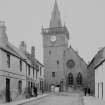Field Visit
Date 20 July 1927
Event ID 1099130
Category Recording
Type Field Visit
Permalink http://canmore.org.uk/event/1099130
Parish Church.
The church stands at the east end of the High Street, probably on the site of the Priory Church. It has been entirely restored and is now relatively modern, but the tower [SC 1108712], which stands at its north-west corner, dates from 1588. It is square on plan, with a projection for a turnpike, circled below and corbelled out to the square at the upperpart. The four lower storeys are built of rubble, harled. The top storey, which contains the clock and two bells, is constructed in ashlar and oversails on a corbel-course. It is surmounted by a corbel-cornice and balustrade, forming "the bertisene of the steeple," (1) and terminates in a graceful stone spire provided with lucarnes. The top storey and spire were probably not completed until the 17th century. The central pedestal of the balustrade bears a spray of three thistles. The northern windows have gun-loops in the sills. The ground floor is vaulted.
BELLS. The larger bell, measuring 25 ½ inches in diameter by 19 ½ inches in height, is enriched with fillets, crest, and scroll-work, and bears the inscription: HAFVER SIORAN PVTENS EFTER LATNA ENKA LATITGIVTA AR I663. I.e."Cast by the late Joran [=George] Putensen's widow and successor in the year 1663." Putensen was a Danish bell-founder working in Stockholm and made many fine bells. (Cf. p. 23.) For the rendering and information we are indebted to Dr. Mats Amark, Upsala, Sweden. Under the word EFTER is a small medallion, but the subject cannot be seen. The other bell, dating from 1742, has been recast.
CARVED PANEL. Inserted in the vestry is a panel of oak, measuring 25 ½ by 15 ½ inches and representing, in deep relief, the Last Supper, Fig. 359. It came from a house in the High Street and is probably of Dutch workmanship. Originally it was in the Priory.
DATED PANEL. On the exterior of the south wall of the church is inserted a panel with the date 1532.
SEPULCHRAL MONUMENTS. On the north side of the church is a recumbent slab, 2 ¾ feet broad and with a present length of 4 ½ feet, which bears in high relief the worn effigy of a man in 17th-century costume, flanked by the initials I.W. Beside this slab lies the coped stone of William Watson, sometime bailie, who died in 1657. On the upper surface is a shield bearing: A cross patty between two crescents in chief and two stars in base. On the south wall of the church is the mural monument of George Hamilton of Cairns, sometime minister of Pittenweem, who died in 1673. At the bottom is his coat of arms. The crest is an open Bible, the motto, LEGO CREDO. The shield is parted per pale: dexter, on a fess, between three cinquefoils, a man's heart, for Hamilton of Cairns; sinister, four annulets, on a chief three mullets, and on an inescutcheon at fess a heart. The north wall of the churchyard contains the remains of a Renaissance mural monument, into which have been inserted three stones, not necessarily related, bearing inscriptions in late Gothic lettering, now indecipherable.
RCAHMS 1933, visited 20 July 1927.
(1) Stat. Acct., iv, p. 376.







